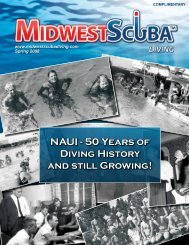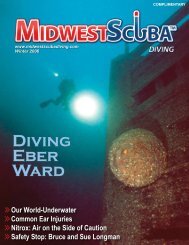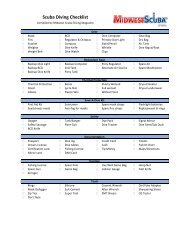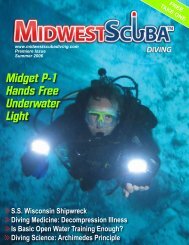great white shark adventure - Midwest Scuba Diving Magazine
great white shark adventure - Midwest Scuba Diving Magazine
great white shark adventure - Midwest Scuba Diving Magazine
Create successful ePaper yourself
Turn your PDF publications into a flip-book with our unique Google optimized e-Paper software.
GREAT WHITE SHARK ADVENTURE<br />
When Richard and I got married in October<br />
of 2000 we never dreamed that we’d be<br />
celebrating our 7th wedding anniversary in the<br />
cold waters of the Pacific peering through the<br />
bars of a <strong>shark</strong> cage at the silent and hauntingly<br />
beautiful form of a <strong>great</strong> <strong>white</strong> <strong>shark</strong>.<br />
It all came about when we joined an Incredible<br />
Adventures’ trip to the Farallon Island Marine<br />
Sanctuary aboard the sixty-five foot vessel<br />
Tamalpais based in Tiburon, a picturesque<br />
bay side town just a few miles north of San<br />
Francisco. In the fall months, from September<br />
through mid-November, <strong>great</strong> <strong>white</strong> <strong>shark</strong>s<br />
congregate in the waters off the Farallones<br />
attracted by the seals, sea lions and their<br />
favorite food source, baby elephant seals that<br />
are there in abundance at this time of year.<br />
We arrived at the dock at 5:30 a.m. where Greg<br />
Barron of Incredible Adventures, Inc. and dive<br />
instructor Francesca Koe greeted us warmly.<br />
The friendly and efficient crew quickly sized<br />
us up for wetsuits and made sure that all the<br />
gear we’d need for a dip in the cold Pacific<br />
was brought aboard. We joined the other<br />
Great White Shark<br />
Adventure<br />
passengers in the spacious and comfortable<br />
main cabin where we were encouraged to help<br />
ourselves to a delicious array of coffee cakes,<br />
muffins, bagels, fruit and beverages.<br />
After a brief orientation to the boat and<br />
safety procedures, we were free to roam the<br />
Tamalpais on our own and enjoyed exploring<br />
the two decks where there was plenty of inside<br />
and outside viewing and lounging space.<br />
By 6:00 a.m. we were underway, motoring<br />
through the dark morning fog toward the<br />
Golden Gate and the open ocean. As we<br />
passed under the bridge we all looked up and<br />
were awed by the beauty of the soft diffused<br />
lights flickering against the massive vertical<br />
support structures which rose from the black<br />
water and disappeared into a misty shroud.<br />
The trip out to the islands took about two and a<br />
half hours. Peter Winch, the highly informed<br />
naturalist on board, generously answered<br />
questions and shared interesting information<br />
about the natural history of the place we were<br />
about to visit. Along the way we slowed down<br />
By Nan E. Temple Talaga<br />
to watch humpback whales spouting and<br />
surfacing nearby, and we saw seals leaping<br />
happily along on their own journeys.<br />
When we arrived at the Farallones, we<br />
circumnavigated the jagged, ruggedly beautiful<br />
islands textured by cormorants, murres, gulls<br />
and other birds along with the velvety brown<br />
log-like forms of hundreds of sea lions lying<br />
in repose along the sea cliff walls. The fishy<br />
smell of guano was nothing, we were told,<br />
compared to the overpowering odor of the<br />
spring bird breeding season when practically<br />
every square inch of the islands are covered<br />
with nesting birds and the researchers must<br />
wear rain ponchos and hard hats to protect<br />
themselves.<br />
We anchored on the south, leeward side of the<br />
island near Saddle Rock. The <strong>shark</strong> cage, which<br />
can accommodate eight divers and is said to be<br />
the world’s largest, was quickly lowered into<br />
the water and secured along the port side. The<br />
top of the cage was at the surface while the<br />
bottom reached down to a depth of about eight<br />
feet. Decoys made from carpeting, resembled<br />
baby elephant seals, and were placed in the<br />
water suspended by lines. They bobbed on the<br />
surface of the water, designed to attract their<br />
most formidable predators, the <strong>great</strong> <strong>white</strong><br />
<strong>shark</strong>s. Chumming (or baiting) the water with<br />
real bait is not allowed in the Farallones in an<br />
effort to keep the natural ecosystem intact.<br />
While there is a good likelihood of seeing<br />
<strong>white</strong> <strong>shark</strong>s at this time of year, at least on<br />
the surface, it was explained to us that there<br />
is no guarantee that you will see one. After<br />
all, this is a wild, natural environment and the<br />
<strong>shark</strong>s are free to do as they please.<br />
People prepared to enter the <strong>shark</strong> cage were<br />
quickly trained to use the hookah system<br />
for breathing underwater through regulators<br />
attached to long hoses through which<br />
compressed air is pumped from onboard. The<br />
crew assisted each diver into the cage and<br />
constantly supervised. Divers could enter<br />
and exit the <strong>shark</strong> cage whenever they wanted<br />
throughout the day. Hot chocolate and soup<br />
along with plenty of good food were provided<br />
to warm up chilly bodies. Fresh towels were<br />
plentiful.<br />
In the afternoon, while Richard and I were<br />
donning our wetsuits preparing for our first<br />
entry into the cage, we heard someone scream<br />
“Shark! Shark! Shark!” When I looked out<br />
a port side window there was a flurry of bird<br />
activity about a hundred yards or more away<br />
from the boat, and I spotted two black fins<br />
breaking through the surface in the midst<br />
of a swath of water that was bright red with<br />
blood. Eyewitnesses told us that a <strong>great</strong> <strong>white</strong><br />
had just breached the surface with a seal in its<br />
jaws, followed by an explosive balloon of red<br />
blood bursting into the air.<br />
The captain carefully maneuvered the<br />
Tamalpais closer to the attack area and set<br />
the anchor. Richard and I, along with two<br />
members of a news crew from Fresno and<br />
another diver from New York, went into the<br />
<strong>shark</strong> cage for the first time. I was wearing a<br />
7mm wetsuit with an attached hood and heavy<br />
gloves and boots. The water felt coldest on my<br />
head and feet, and I found myself breathing<br />
hard for the first few minutes until I became<br />
accustomed to the cold and the water in my<br />
suit had a chance to warm up a bit. At first we<br />
saw only water, which was fairly clear with<br />
about 30 to 40 feet of visibility. Large round<br />
<strong>white</strong> moon jellies drifted by, clearly visible<br />
against the green blue color of the seawater.<br />
The thirty pounds of weight I was wearing<br />
had made me negatively buoyant, and I found<br />
myself bouncing on my tiptoes against the<br />
bottom of the cage as it moved with the waves<br />
in the water. Richard was next to me looking<br />
over the side of the cage toward the bottom<br />
when he suddenly held his hand against his<br />
forehead in a signal indicating <strong>shark</strong>. By the<br />
time I looked far enough down in the direction<br />
he had pointed there was nothing. I continued<br />
scanning the area in front and beneath the cage<br />
when I saw Richard pointing down again.<br />
This time I saw the <strong>shark</strong>. It was there, big<br />
and slightly on its side so that you could see<br />
the light <strong>white</strong> underbelly and the dark back<br />
meeting along the side of its massive body as<br />
it gently moved from left to right just about 15<br />
to 20 feet below us. Its mouth was closed and<br />
it looked completely at ease and in control.<br />
And then it was gone. We waited for a while<br />
but it never came back. I guess it had seen<br />
enough of us.<br />
Our <strong>shark</strong> sighting was the only one from the<br />
cage that day. There were only four of us<br />
who happened to see it. The fifth person in<br />
the cage, who so desperately wanted to see a<br />
<strong>shark</strong>, missed it and was deeply disappointed.<br />
Had I not seen the <strong>shark</strong> that day, I don’t think<br />
I would have minded. I got to see a wild place<br />
where humans don’t really belong and felt the<br />
power of the natural forces that exist there.<br />
But there was something in that moment when<br />
I saw the <strong>white</strong> <strong>shark</strong> and he saw me, too that<br />
will live in me forever.<br />
We left the Farallones at about 2:30 heading<br />
back for harbor. The smell of freshly baked<br />
chocolate chip cookies wafted through the main<br />
cabin followed by the third excellent meal of<br />
the day. The time passed quickly as Richard<br />
and I stood on the bow of the Tamalpais full<br />
of energy and the experience of our beautiful<br />
day, a fitting celebration of seven wonderful<br />
years of married life. We talked easily with<br />
other passengers who shared the day’s voyage<br />
and when we looked back we saw a margin<br />
of shimmering golden light along the horizon<br />
CD’s<br />
7<br />
Pool & <strong>Scuba</strong><br />
We offer basic training through<br />
advanced certifications and are<br />
the best full service dive shop in<br />
Northern Indiana. We have <strong>great</strong><br />
prices on all gear.<br />
Call today for our<br />
specials!<br />
Phone: 574-295-7300<br />
23672 Old US 20<br />
Elkhart, IN 46516<br />
MIDWEST SCUBA DIVING FALL 2007 FALL 2007 MIDWEST SCUBA DIVING










